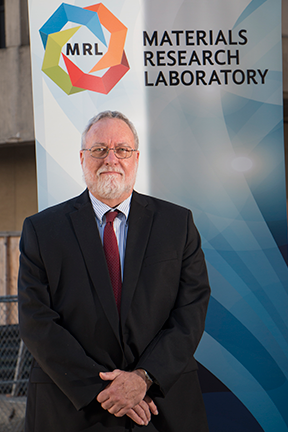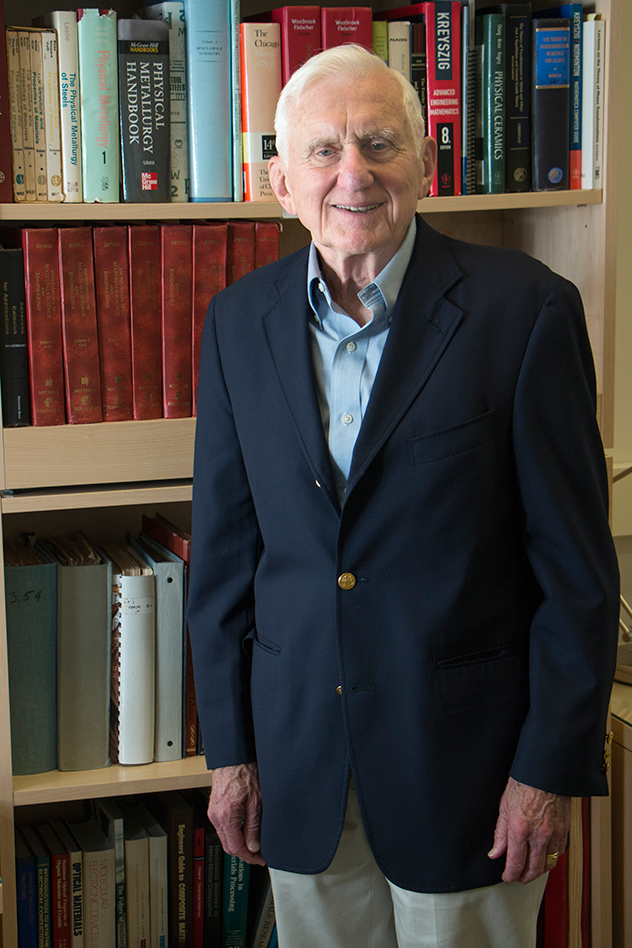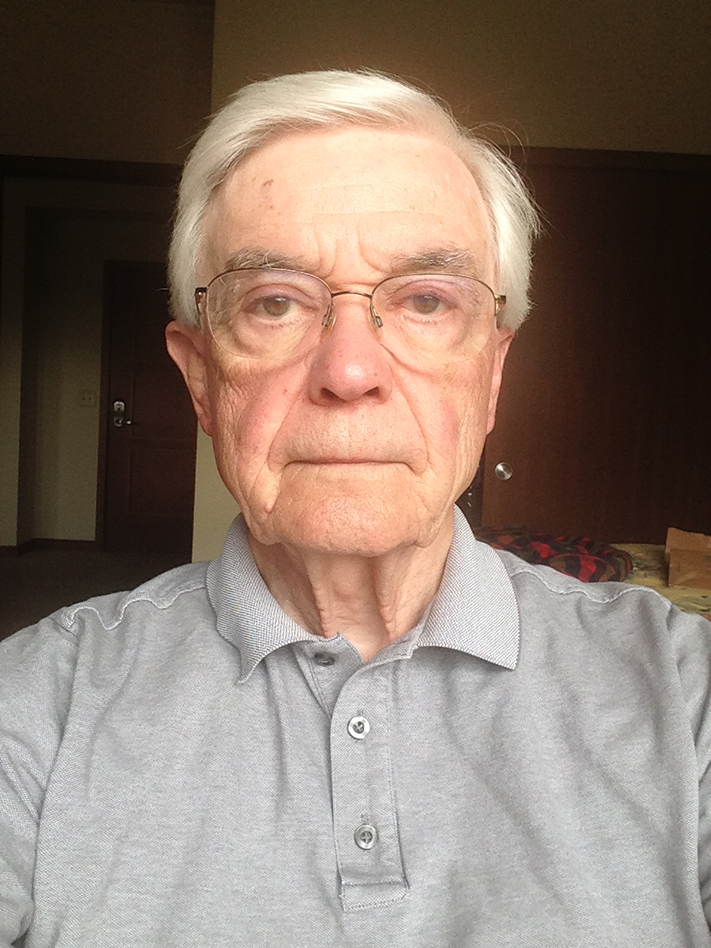Merger of the Materials Processing Center and the Center for Materials Science and Engineering melds a rich history of materials science and engineering breakthroughs
The Materials Research Laboratory at MIT starts from a foundation of fundamental scientific research, practical engineering applications, educational outreach and shared experimental facilities laid by its merger partners, the Materials Processing Center and the Center for Materials Science and Engineering.
“We’re bringing them together and that will make communication both inside and outside MIT easier and will make it clearer especially to people outside MIT that for interdisciplinary research on materials, this is the place to learn about it,” says MRL Director Carl V. Thompson.

The Materials Research Laboratory serves interdisciplinary groups of faculty researchers, spanning the spectrum of basic scientific discovery through engineering applications and entrepreneurship to ensure that research breakthroughs have impact on society. The center engages with approximately 150 faculty members and scientists from across the Schools of Science and Engineering who are conducting materials science research. MRL will work with MIT.nano to enhance the toolset available for groundbreaking research as well as collaborate with the MIT Innovation Initiative and The Engine.
MRL will benefit from the long history of research breakthroughs under MPC and CMSE such as “perfect mirror” technology developed through CMSE in 1998 that led to a new kind of fiber optic surgery and a spinout company, OmniGuide Surgical, and the first germanium laser operating at room temperature, which is used for optical communications, in 2012 through MPC’s affiliated Microphotonics Center.
The Materials Processing Center brings to the partnership its wide diversity of materials research, funded by industry, foundations and government agencies, while the Center for Materials Science and Engineering brings its seed projects in basic science and Interdisciplinary Research Groups, educational outreach and shared experimental facilities, funded under the National Science Foundation Materials Research Science and Engineering Center program [NSF-MRSEC]. Combined research funding was $21.5 million for the fiscal year ended June 30, 2017.
MPC’s research volume more than doubled during the past nine years under Thompson’s leadership. “We do have a higher profile in the community both internal as well as external. We developed over the years a close collaboration with CMSE, including outreach. That will be greatly amplified through the merger,” he says. Thompson is the Stavros Salapatas Professor of Materials Science and Engineering at MIT.
Tackling energy problems
With industrial support, MPC and CMSE launched the Substrate Engineering Lab in 2004. MPC affiliates include the AIM Photonics Academy, the Center for Integrated Quantum Materials and the MIT Skoltech Center for Electrochemical Energy Storage. Other research includes Professor Harry L. Tuller’s Chemomechanics of Far-From-Equilibrium Interfaces (COFFEI) project, which aims to produce better oxide-based semiconductor materials for fuel cells, and Senior Research Scientist Jurgen Michel’s Micro-Scale Optimized Solar-Cell Arrays with Integrated Concentration (MOSAIC) project, which aims to achieve overall efficiency of greater than 30 percent.
The MPC kicked off the Singapore-MIT Alliance for Research and Technology Center’s program in Low Energy Electronic Systems [SMART-LEES] in January 2012, managing the MIT part of the budget. SMART-LEES, led by Eugene A. Fitzgerald, the Merton C. Flemings-SMA Professor of Materials Science and Engineering at MIT, was renewed for another five years in January 2017.
Shared experimental facilities, including X-Ray diffraction, scanning and transmission electron microscopy, probe microscopy, and surface analytical capabilities, are used by more than 1,100 individuals each year. “The amount of investment that needs to be made to keep state-of-the-art shared facilities at a university like MIT is on the order of 1 to 2 million dollars per year in new investment and new tools. That kind of funding is very difficult to get. It certainly doesn’t come to us through just NSF funding,” says TDK Professor of Polymer Materials Science and Engineering Michael F. Rubner, who is retiring after 16 years as CMSE director. “MIT.nano, in concert with MRL, will be able to work together to look at new strategies for trying to maintain state-of-the-art equipment and to find funding sources and to figure out ways to not only get the equipment in, but to have highly trained professionals running that equipment.”
Associate Professor of Materials Science and Engineering Geoffrey S.D. Beach succeeds Rubner as co-director of the MIT MRL and principal investigator for the NSF-MRSEC.
Spinning out jobs
NSF-MRSEC-funded research through CMSE has led to approximately 1,100 new jobs through spinouts such as American Superconductor [superconductivity], OmniGuide Surgical [optical fibers] and QD Vision [quantum dots], which Samsung acquired in 2016. Many of these innovations began with seed funding, CMSE’s earliest stage of support, and evolved through joint efforts with MPC, such as microphotonics research that began with a seed grant in 1993, followed by Interdisciplinary Research Group funding a year later. In 1997, MIT researchers published two key papers in Nature and Physical Review Letters, won a two-year, multi-university award through DARPA for Photonic Crystal Engineering, and formed the Microphotonics Center. Further research led to the spinout in 2002 of Luminus Devices, which specializes in solid-state lighting based on light emitting diodes [LEDs].

“Our greatest legacy is bringing people together to produce fundamental new science, and then allowing those researchers to explore that new science in ways that may be beneficial to society, as well as to develop new technologies and launch companies,” Rubner says. He recalls that research in complex photonic crystal structures began with Francis Wright Davis Professor of Physics D. Joannopoulos as leader. “They got funding through us, at first as seed funding and then IRG [interdisciplinary research group] funding, and over the years, they have continued to get funding from us because they evolved. They would seek a new direction, and one of the new directions they evolved into was this idea of making photonic fibers, so they went from photonic crystals to photonic fibers and that led to, for example, the launching of OmniGuide.” An outgrowth of basic CMSE research, the company’s founders included Professors Joannopolous, Yoel Fink, and Edwin L. [“Ned”] Thomas, who served as William and Stephanie Sick Dean of the George R. Brown School of Engineering at Rice University from 2011 to 2017.
Under Fink’s leadership, that work evolved into Advanced Functional Fabrics of America [AFFOA], a public-private Manufacturing Innovation Institute devoted to creating and bringing to market revolutionary fibers and textiles. The institute, which is a separate nonprofit organization, is led by Fink, while MIT on-campus research is led by Lammot du Pont Professor of Chemical Engineering Gregory C. Rutledge.
Susan D. Dalton, NSF-MRSEC Assistant Director, recalls the evolution of perfect mirror technology into life-saving new fiber optic surgery. “From an administrator’s point of view,” Dalton says, “it’s really exciting because day to day, things happen that you don’t know are going to happen. When you think about saving people’s lives, that’s amazing, and that’s just one example,” she says.
Government, industry partners
Through its Collegium and close partnership with the MIT Industrial Liaison Program (ILP), MPC has a long history of government and industrial partnerships as well as individual faculty research projects. Merton C. Flemings, who is MPC’s founding director [1980-82], and a retired Toyota Professor of Materials Processing, recalls that the early focus was primarily on metallurgy, but ceramics work also was important. “It’s gone way beyond that, and it’s a delight to see what’s going on,” he notes.
“From the time of initiation of the MPC, we had interdepartmental participation, and quite soon after its formation, we initiated an industrial collegium to share in research formulation and participate in research partnerships. I believe our collegium was the first to work collaboratively with the Industrial Liaison Program. It was also at a period in MIT history when working directly with the commercial sector was rare,” Flemings says.
Founded in February 1980, the Materials Processing Center won early support from NASA, which was interested in processing materials in space. A question being asked then was: “What would it be like when you’re in zero gravity and you try and purify a metal or make anything out there? Dr. John R. Carruthers headed this zero gravity materials processing activity in NASA, and as he considered the problem, he realized we didn’t really have much of a science base of materials processing on earth, let alone in space. With that in mind, at Carruthers’ instigation, NASA provided a very generous continuing grant to MIT that was essential to us starting in those early years,” Flemings explains.
Carruthers went on to become director of research with Intel and is now Distinguished Professor of Physics, at Portland [Oregon] State University. The two men – Flemings at MIT and Carruthers at the University of Toronto – had been familiar with each other’s work in the study of how metals solidify, before Carruthers joined NASA as director of its materials processing in space program in 1977. Both Flemings and Carruthers wanted to understand how the effects of gravitationally driven convection influenced the segregation processes during metals solidification.

“In molten metal baths, as the metal solidifies into ingots, the solidification process is never uniform. And so the distribution of the components being solidified is very much affected by fluid flow or convection in the molten metal,” Carruthers explains. “We were both interested in what would happen if you could actually turn gravity down because most of the convective effects were influenced by density gradients in the metal due to thermal and compositional effects. So, we were quite interested in what would happen given that those density gradients existed, if you could actually turn the effects of gravity down.”
Expanding research portfolio
“When the NASA program came around, they wanted to try to use the low gravity environment of space to actually fabricate materials,” Carruthers recalls. “After a couple of years at NASA, I was able to secure some block grant funding for the center. It subsequently, of course, has developed its own legs and outgrown any of the initial funding that we provided, which is really great to see, and it’s a tribute to the MIT way of doing research, of course, as well. I was really quite proud to be part of the early development of the center,” Carruthers says. “Many of the things we learned in those days are relevant to other areas. I’m finding a lot of knowledge and way of doing things is transferrable to the biomedical sciences, for example, so I’ve become quiet interested in helping to develop things like nanomonitors, you know, more materials science-oriented approaches for the biomedical sciences.”
From its beginnings in metals processing with NASA support, MPC evolved into a multi-faceted center with diverse sponsors of research in energy harvesting, conversion and storage; fuel cells; quantum materials and spintronics; materials integration for microsystems; photonic devices and systems; materials systems and sustainability; solid-state ionics; as well as metals processing, an old topic that is hot again.
MRL-affiliated MIT condensed matter physicists include experimentalists Raymond C. Ashoori, Joseph G. Checkelsky, Nuh Gedik, and Pablo Jarillo-Herrero, who are exploring quantum materials for next-generation electronics, such as spintronics and valleytronics, new forms of nanoscale magnetism, and graphene-based optoelectronic devices. Riccardo Comin explores electronic phases in quantum materials. Theorists Liang Fu and Senthil Todadri envision new forms of random access memory, Majorana fermions for quantum computing, and unusual magnetic materials such as quantum spin liquids.
In the realm of biophysics, Associate Professor Jeff Gore tests fundamental ideas of theoretical ecology and evolutionary dynamics through experimental studies of microbial communities. Class of 1922 Career Development Assistant Professor Ibrahim Cissé uses physical techniques that visualize weak and transient biological interactions to study emergent phenomena in live cells with single molecule sensitivity. On the theoretical front, Professor Thomas D. & Virginia W. Cabot Career Development Associate Professor of Physics Jeremy England focuses on structure, function, and evolution in the sub-cellular biophysical realm.
Alan Taub, Professor of Materials Science and Engineering at the University of Michigan, has become a member of the new Materials Research Laboratory External Advisory Board. Taub previously served in senior materials science management roles with General Motors, Ford Motor Co. and General Electric and served as chairman of the Materials Processing Center Advisory Board from 2001-2006. He notes that under Director Lionel Kimerling [1993-2008], MPC embraced the new area of photonics. “That transition was really well done,” Taub says. The MRL-affiliated Microphotonics Center has produced collaborative roadmapping reports since 2007 to guide manufacturing research and address systems requirements for networks that fully exploit the power of photonics. Taub also is chief technical officer of LIFT Manufacturing Innovation Institute, in which MIT Assistant Professor of Materials Science and Engineering Elsa Olivetti and senior research scientist Randolph E. [Randy] Kirchain are engaged in cost modeling.
From its founding, Taub notes, MPC engaged the faculty with industry. Advisory board members often sponsored research as well as offering advice. “So it was really the way to guide the general direction, you know, teach them that there are things industry needs. And remember, this was the era well before entrepreneurism. It really was the interface to the Fortune 500’s and guiding and transitioning the technology out of MIT. That’s why I think it survived changes in technology focus, because at its core, it was interfacing industry needs with the research capabilities at the Institute,” Taub says.

Broadening participation
Susan Rosevear, who is the Education Officer for the NSF-MRSEC, is responsible for an extensive array of programs, including the Summer Scholars program, which is primarily funded through NSF’s Research Experience for Undergraduates (REU) program. Each summer a dozen or so top undergraduates from across the country spend about two months at MIT as lab interns working with professors, postdocs and graduate students on cutting edge research.
CMSE also conducts summer programs for community college students and teachers, middle and high school teachers, and participates in the Women’s Technology Program and Boston Area Girls' STEM Collaborative. “Because diversity is also part of our mission, part of what our mission from NSF is, in all we do, we try to broaden participation in science and engineering,” Rosevear says.
Teachers who participate in these programs often note how collaborative the research enterprise is at MIT, Rosevear notes. Several have replaced cookbook-style labs with open-ended projects that let students experience original research.
Confidence to test ideas
Merrimack [N.H.] High School chemistry teacher Sean Müller first participated in the Research Experience for Teachers program in 2000. “Through my experiences with the RET program, I have learned how to ‘run a research group’ consisting of my students. Without this experience, I would not have had the confidence to allow my students to research, develop, and test their original ideas. This has also allowed me to coach our school’s Science Olympiad team to six consecutive state titles, to mentor a set of students that developed a mini bio-diesel processor that they sold to Turner Biodiesel, and to mentor another set of students that took second place in Embedded Systems at I.S.E.F. [Intel International Science and Engineering Fair] last year for their ChemiCube chemical dispensing system,” Müller says.
Müller says he is always looking for new ideas and researching older ideas to develop lab activities in his classroom. “One year my students made light emitting thin films. We have grown beautiful bismuth crystals in our test furnace, and currently I am working out how to make glow-in-the-dark zinc sulfide electroluminescent by doping it with copper so that we can make our own electroluminescent panels,” he says. “Next year we are going to try to make the clear see-through wood that was in the news earlier this year. I am also bringing in new materials that they have not seen before such as gallium-indium eutectic. These novel materials and activities generate a very high level of enthusiasm and interest in my students, and students that are excited, interested, and motivated learn more efficiently and more effectively.”
Müller developed a relationship with Prof. Steve Leeb that has brought Müller back to MIT during past summers to present a brief background in polymer chemistry, supplemented by hands-on demonstrations and activities, for the Science Teacher Enrichment Program (STEP) and Women’s Technology program. “Last year I showed them how they could use their cell phone and a polarized film to see the different areas of crystallization in polymers when they are stressed,” Müller says. “I enjoy the presentation because it is more of a conversation with all of the teachers, myself included, asking questions about different activities and methods and discussing what has worked and what has not worked in the past.”
Conducive environment
Looking back on his nine years as MPC director, Thompson says, “The MPC served a broad community, but many people at MIT didn’t know about it because it was in the basement of Building 12. So one of the things that I wanted to do was raise the profile of MPC so people better understood what the MPC did in order to better serve the community.” MPC rolled out a new logo and developed a higher profile Web page, for example. “I think that was successful. I think many more people understand who we are and what we do and that enables us to do more,” Thompson says. In 2014 MPC moved to Building 24 as the old Building 12 was razed to make way for MIT.nano. The new MRL is consolidating its offices in Building 13.
“Research breakthroughs by their very nature are hard to predict, but what we can do is we can create an environment that leads to research breakthroughs,” Thompson says. “The successful model in both MPC and CMSE is to bring together people interested in materials, but with different disciplinary backgrounds. We’ve done that separately, we’ll do it together, and the expectation is that we’ll do it even more effectively.”
Materials Research Laboratory
October 10, 2017
Updated January 25, 2018
